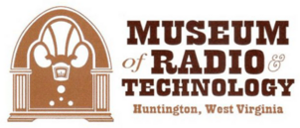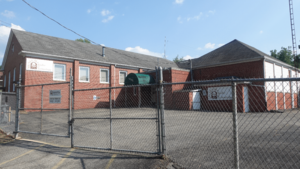Museum of Radio and Technology facts for kids
 |
|

Museum of Radio and Technology in 2024.
|
|
| Established | 1991 |
|---|---|
| Location | 1640 Florence Ave, Huntington, West Virginia, 25701 |
| Type | Electronic Communication and Entertainment |
The Museum of Radio and Technology is a cool place in Huntington, West Virginia. It's a museum where you can learn all about how electronic communication and entertainment started and grew over time. You can even try out some of the exhibits yourself! The best part is, it's free to visit.
Contents
- A Look Back: Museum History
- What You'll Discover at the Museum
- Step into a 1920s-1930s Radio Shop
- Explore a 1940s-1950s Showroom
- Journey Through Computer History
- Check Out the Gift Shop
- Discover Ham and Shortwave Radios
- See Military Communication Gear
- Visit a Modern Ham Radio Station
- Learn in the Radio Classroom
- Remember Harveytown School Days
- Step into a Radio DJ Studio
- Explore the Broadcasting Room
- West Virginia Broadcasting Hall of Fame
- The Museum Library
- The Auditorium and Stage
- More to Explore
A Look Back: Museum History
The Museum of Radio and Technology first opened its doors in 1991. It's located in an old building that used to be the Harveytown Elementary School. This school is in the Harveytown neighborhood of Huntington.
What You'll Discover at the Museum
The museum has many exciting areas to explore. Each section shows a different part of how technology changed.
Step into a 1920s-1930s Radio Shop
Your adventure starts by looking at how music was played before electricity. You'll see how wireless communication began. There's even a working "crystal radio" and a cool machine that makes sparks to show how early radios worked.
Explore a 1940s-1950s Showroom
Imagine walking into a radio and TV store from the past! This area looks just like a typical showroom from the 1940s and 1950s. You'll see old tube radios, early television sets, and even wire and tape recorders. There are also vintage record players. Plus, there's a big display of 1950s toys from the A.C. Gilbert Company. These include classic Erector sets, chemistry sets, and microscopes.
Journey Through Computer History
See how computers have changed over the years. This display shows a "timeline" of desktop computers. You'll see early models like the IMSAI all the way to the first Mac and Lisa computers. You can even see a 7-megabyte hard drive that was as big as a suitcase! Today, your phone probably has thousands of times more storage.
Check Out the Gift Shop
Before you leave, stop by the gift shop. You can find clothing, toys, books, and magazines. They also have antique and reproduction radios. Sometimes, you can even find old wind-up Victrola phonographs and records for sale!
Discover Ham and Shortwave Radios
This section is all about short-wave radios. These are used by "hams" (amateur radio operators) and hobbyists. You'll see famous brands like Hallicrafters and Heath.
See Military Communication Gear
Learn about how the military communicated in the past. This display has different types of military radio and communication equipment.
Visit a Modern Ham Radio Station
The museum has its own amateur radio station, called WV8MRT. If you have a special license, you might even be able to operate it yourself!
Learn in the Radio Classroom
This room is set up for teaching about electronics. It has test equipment and special displays that show how electronic circuits work.
Remember Harveytown School Days
The museum building used to be an elementary school. In this area, you can learn about the children who went to classes here. It covers the years from the 1920s to the 1970s.
Step into a Radio DJ Studio
Ever wondered what it was like to be a radio DJ? This exhibit is a working broadcast studio. It's just like the ones disc jockeys used from the early 1950s to the late 1990s. You can sit at the control board and imagine you're on the air!
Explore the Broadcasting Room
This room shows off radio and TV broadcast equipment. You'll see a huge 5000-watt AM transmitter from the 1930s. There are also old recorders, cameras, and control boards. You might even hear those famous "N-B-C" chimes!
West Virginia Broadcasting Hall of Fame
A special part of the museum honors people from West Virginia who were very important in the early days of broadcasting. You can see pictures, read their stories, and find their names on a special wall.
The Museum Library
The museum has a library filled with books, magazines, and other publications about radio and electronics. It's a great resource for anyone wanting to learn more.
The Auditorium and Stage
This large area is used for special events. The museum holds auction sales and swap meets here three times a year. The annual Hall of Fame ceremony and Radio Dinner Theater also happen on this stage. You can even rent these facilities and the nearby kitchen for your own private events.
More to Explore
- List of museums in Huntington, West Virginia
- American Museum of Radio and Electricity
- Museum of Broadcast Communications
- 20th Century Technology Museum
- National Radio Hall of Fame
- Military Wireless Museum in the Midlands

